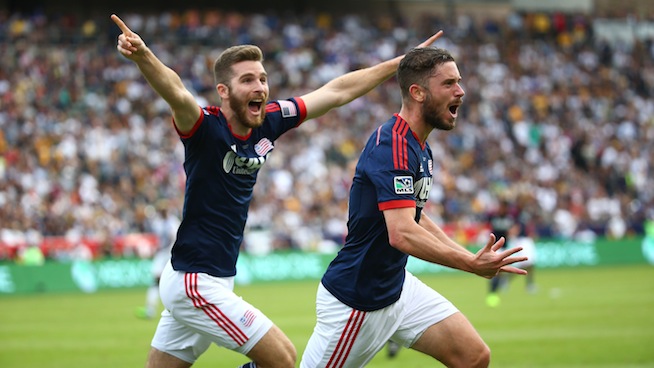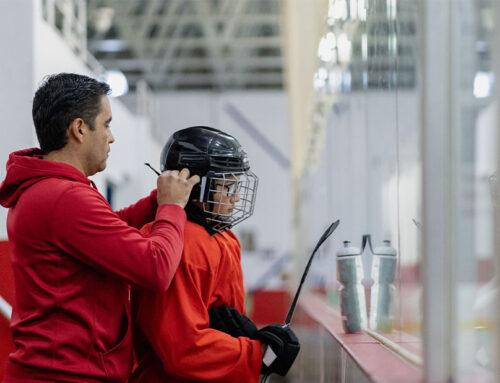4 Soccer Off-Season Conditioning Drills from the New England Revolution

As soccer season approaches, fitness and conditioning are high priorities—and hotly debated topics. As the strength and conditioning coach for the New England Revolution, I need to make sure our players are ready to go when the coach calls on them. This allows us to field our best 11 players every game, and ultimately leads to more success.
Soccer includes short, very intense bursts of energy using the alactic energy system, coupled with slow jogging or walking using the aerobic energy system. In the off-season, we focus on developing both of those systems to build a high base level of fitness, hoping to reduce injuries. This also allows us to use speed training and small-sided games to stay sharp during the season. Yes, we still do aerobic work on regeneration days during the season
During games, players spend massive amounts of energy sprinting at max effort for short periods, followed by longer periods of rest and recovery; so we train to simulate that. Intensity is the key when training for soccer. But rest is also critical to ensure the effectiveness of the drills. Focus on the quality and intensity of the work, not the quantity.
Here are three drills I use with the Revolution. You can perform them on your own or in a team setting, as we often do.
Soccer Ball Relay Race
A simple relay race with a ball is one of my favorites to enhance visual reaction time, 5- to 15-yard explosiveness and foot skills.
How to: Set up five flags positioned 1 yard apart. On a whistle, the player dribbles through the flags. Once completed, he turns and passes the ball to the next person in line and sprints 3 to 5 yards beyond the starting line.
Sets/Reps: 4×1; rest 5 to 7 times as long as you work
Half-Kneeling Starts
These improve reaction time, core activation, quickness over 2 to 5 yards, deceleration and acceleration.
How to: Stand on the sideline facing the center of the field. Turn to the right to straddle the line. Kneel down so your right knee and left foot are on the sideline in a narrow lunge position. On a whistle, jump laterally off your left foot to the right. Land softly on your right foot and immediately sprint toward the center of the field for the specified distance.
Sets/Distance: 4×5-15 yards; rest 5 to 7 times as long as you work
Striders
We vary the speeds and distances of this drill depending on the day, our game schedule, player availability and their positions. Striders are often used as a regeneration exercise after a game or as a way for some players to gain aerobic fitness without taking too much out of their tanks.
How to: Stand in the corner of the field with a ball, ideally while wearing a heart rate monitor. Run with the ball anywhere from 100 to 400 yards in 14 to 60 seconds. Stop if your heart rate goes above 155 beats per minute. Start again once your heart rate drops to 120-125 beats per minute.
Sets: 5-15
RECOMMENDED FOR YOU
MOST POPULAR
4 Soccer Off-Season Conditioning Drills from the New England Revolution

As soccer season approaches, fitness and conditioning are high priorities—and hotly debated topics. As the strength and conditioning coach for the New England Revolution, I need to make sure our players are ready to go when the coach calls on them. This allows us to field our best 11 players every game, and ultimately leads to more success.
Soccer includes short, very intense bursts of energy using the alactic energy system, coupled with slow jogging or walking using the aerobic energy system. In the off-season, we focus on developing both of those systems to build a high base level of fitness, hoping to reduce injuries. This also allows us to use speed training and small-sided games to stay sharp during the season. Yes, we still do aerobic work on regeneration days during the season
During games, players spend massive amounts of energy sprinting at max effort for short periods, followed by longer periods of rest and recovery; so we train to simulate that. Intensity is the key when training for soccer. But rest is also critical to ensure the effectiveness of the drills. Focus on the quality and intensity of the work, not the quantity.
Here are three drills I use with the Revolution. You can perform them on your own or in a team setting, as we often do.
Soccer Ball Relay Race
A simple relay race with a ball is one of my favorites to enhance visual reaction time, 5- to 15-yard explosiveness and foot skills.
How to: Set up five flags positioned 1 yard apart. On a whistle, the player dribbles through the flags. Once completed, he turns and passes the ball to the next person in line and sprints 3 to 5 yards beyond the starting line.
Sets/Reps: 4×1; rest 5 to 7 times as long as you work
Half-Kneeling Starts
These improve reaction time, core activation, quickness over 2 to 5 yards, deceleration and acceleration.
How to: Stand on the sideline facing the center of the field. Turn to the right to straddle the line. Kneel down so your right knee and left foot are on the sideline in a narrow lunge position. On a whistle, jump laterally off your left foot to the right. Land softly on your right foot and immediately sprint toward the center of the field for the specified distance.
Sets/Distance: 4×5-15 yards; rest 5 to 7 times as long as you work
Striders
We vary the speeds and distances of this drill depending on the day, our game schedule, player availability and their positions. Striders are often used as a regeneration exercise after a game or as a way for some players to gain aerobic fitness without taking too much out of their tanks.
How to: Stand in the corner of the field with a ball, ideally while wearing a heart rate monitor. Run with the ball anywhere from 100 to 400 yards in 14 to 60 seconds. Stop if your heart rate goes above 155 beats per minute. Start again once your heart rate drops to 120-125 beats per minute.
Sets: 5-15
RELATED: New England Revolution’s Tips for Precise Passing










